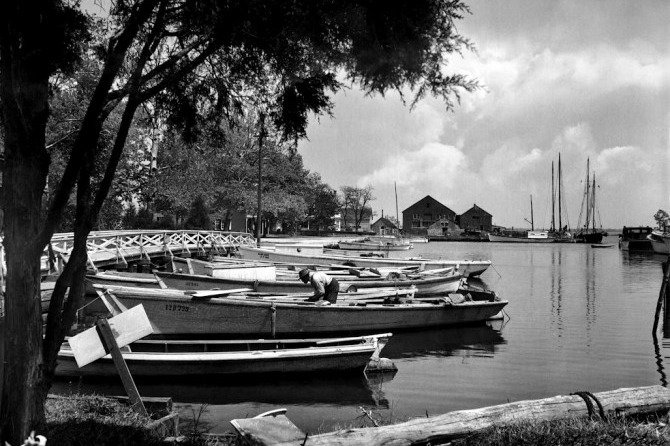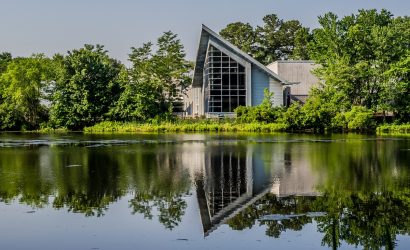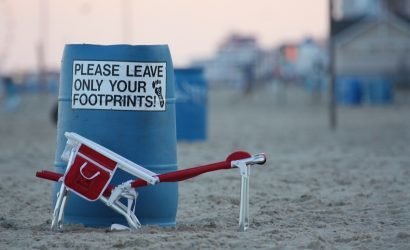There are photographs that capture the unpredictability of the water, the way the sun reflects off of the bay, creating a natural vignette around the ships in the harbor, or the pound fishermen holding on for dear life—and the days catch—as the waves slam over their boats. Yet the photographer that took these iconic images couldn’t swim—an ironic detail illustrating an artist’s fierce devotion to his work. A. Aubrey Bodine, famed photographer for the Baltimore Sun’s Sunday Sun Magazine, spent 50 years photographing life and landscape, much of his subject matter stemming from the love he had for Maryland.
Bodine’s biographer and former editor Harold A. Williams writes in his book Bodine – A Legend in His Time, that Bodine’s favorite, and most successful theme featured water subjects. Perhaps the most famous and widely awarded photograph was taken right here on the Eastern Shore, on the Choptank River. Photographing for a Sun story on oyster dredging, Bodine held onto a mast during a rainstorm to capture the shot. The crew continued to work as if unfazed by the weather. The photo went onto win a $5,000 bond as first place in Popular Photography’s 1949 national contest out of 51,038 entries. Bodine would go onto win many other awards throughout his illustrious career.
Bodine traveled to the Eastern Shore numerous times over the years. One memorable story, as recounted in A Legend in His Time, was of Bodine’s encounter with the Duke and Duchess of Windsor:
Photographing the Duke and Duchess of Windsor when they were visiting the Eastern Shore, Bodine remarked to the former king of England, “You know, you look like someone else I photographed.” And to prove it he produced a copy of his book, “Chesapeake Bay and Tidewater,” turned to page 96, and pointed to a picture of a Deal Island blacksmith.
Another notable trip to the Eastern Shore involved Bodine’s honeymoon. Bodine brought his new wife on assignment with him to Salisbury, MD where she ended up spending time in a public room at the Wicomico Hotel that had been partitioned off for the couple to stay in—as the honeymoon suite, and every other room in the hotel was booked—while her new husband completed his assignment.
A man who obviously loved and displayed a sheer devotion to his work, Bodine got his start in the business office of the Sunpapers as a messenger in 1920. He was all of 14 years old. A freak accident in 1924 involving commercial photographer Herbert Moore and flashpowder gone awry opened up Moore’s position. Bodine, who had accompanied Moore on assignment, was made commercial photographer. Bodine made one more change in positions in his career, in 1927. The Sunday Sun photographer was fired due to a mishap with a staged photograph of a turkey. Bodine lobbied for, and was granted the position; one that he would hold for the rest of his life.
A. Aubrey Bodine passed away in 1970. He was a newspaper photographer with a byline—in the days when that was unheard of. He was an internationally known, celebrated photographer winning countless awards, and his work continues to convey the raw emotion, beauty of light and depth, and appreciation for his subjects that it did decades ago. Bodine’s work was once considered cutting edge and is now timeless. The old saying, “A picture is worth a thousand words,” certainly rings true. View Bodine’s images of life on the water on the Eastern Shore, perfectly conveying a lifestyle perhaps better than words ever could.
View a collection of Bodine’s work in person, featuring photography of the Chesapeake Bay Region at the Ward Museum at Salisbury University. The exhibition is on display from July 13 – September 30th, 2012. More information can be found,here. Reprints of Bodine’s work in various sizes, his photography books, and original photos can be purchased from the A. Aubrey Bodine website.
.jpg) |
.jpg) |
| Quiet Morning St. Michaels (1957) | Kicks on the Beach Ocean City, (1950) |
.jpg) |
.jpg) |
| Ocean City Fishing Dock (1955) | Choptank Oyster Dredgers (as mentioned in the article) (1948) |
.jpg) |
.jpg) |
| Ocean City Sunrise (1970) | Hard Crabs Cape Charles (1950) |
 |
.jpg) |
| Rowing at Ebb Tide (1944) | Crisfield (1945) |









